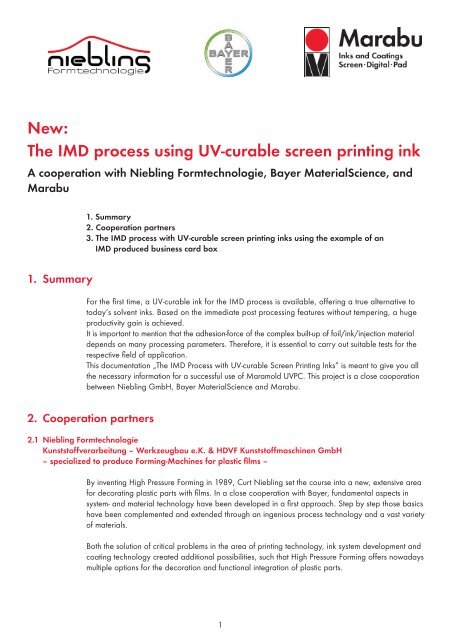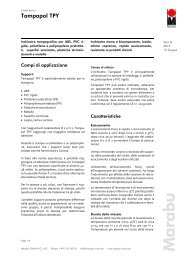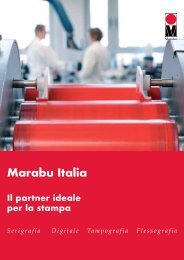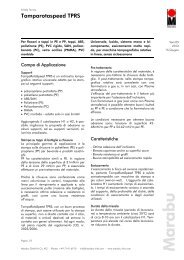New: The IMD process using UV-curable screen printing ink - Marabu
New: The IMD process using UV-curable screen printing ink - Marabu
New: The IMD process using UV-curable screen printing ink - Marabu
Create successful ePaper yourself
Turn your PDF publications into a flip-book with our unique Google optimized e-Paper software.
<strong>New</strong>:<strong>The</strong> <strong>IMD</strong> <strong>process</strong> <strong>using</strong> <strong>UV</strong>-<strong>curable</strong> <strong>screen</strong> <strong>printing</strong> <strong>ink</strong>A cooperation with Niebling Formtechnologie, Bayer MaterialScience, and<strong>Marabu</strong>1. Summary2. Cooperation partners3. <strong>The</strong> <strong>IMD</strong> <strong>process</strong> with <strong>UV</strong>-<strong>curable</strong> <strong>screen</strong> <strong>printing</strong> <strong>ink</strong>s <strong>using</strong> the example of an<strong>IMD</strong> produced business card box1. SummaryFor the fi rst time, a <strong>UV</strong>-<strong>curable</strong> <strong>ink</strong> for the <strong>IMD</strong> <strong>process</strong> is available, offering a true alternative totoday’s solvent <strong>ink</strong>s. Based on the immediate post <strong>process</strong>ing features without tempering, a hugeproductivity gain is achieved.It is important to mention that the adhesion-force of the complex built-up of foil/<strong>ink</strong>/injection materialdepends on many <strong>process</strong>ing parameters. <strong>The</strong>refore, it is essential to carry out suitable tests for therespective field of application.This documentation „<strong>The</strong> <strong>IMD</strong> Process with <strong>UV</strong>-<strong>curable</strong> Screen Printing Inks“ is meant to give you allthe necessary information for a successful use of Maramold <strong>UV</strong>PC. This project is a close cooporationbetween Niebling GmbH, Bayer MaterialScience and <strong>Marabu</strong>.2. Cooperation partners2.1 Niebling FormtechnologieKunststoffverarbeitung – Werkzeugbau e.K. & HDVF Kunststoffmaschinen GmbH– specialized to produce Forming-Machines for plastic films –By inventing High Pressure Forming in 1989, Curt Niebling set the course into a new, extensive areafor decorating plastic parts with films. In a close cooperation with Bayer, fundamental aspects insystem- and material technology have been developed in a first approach. Step by step those basicshave been complemented and extended through an ingenious <strong>process</strong> technology and a vast varietyof materials.Both the solution of critical problems in the area of <strong>printing</strong> technology, <strong>ink</strong> system development andcoating technology created additional possibilities, such that High Pressure Forming offers nowadaysmultiple options for the decoration and functional integration of plastic parts.1
Niebling GmbH builds machines and systems to manufacture 3D formed foil parts both in semi- andfully automated manner. <strong>The</strong> in-house tool shop assembles the necessary forming and trimming toolson customer request and technical requirements. An internal prototype lab enables testing and adjustmentof the entire <strong>process</strong> chain prior to its delivery.Niebling systems use high pressure up to 300bar, allowing the forming of almost all substrate materialsin thicknesses of up to 12mm. Essential characteristic of all Niebling systems is the non-contact heatingsystem, providing the option to generate part specific temperature profiles. <strong>The</strong> interaction of suchtemperature profiles with the continuous pressure control and the precise tooling technology canattain very low positioning tolerances (
Conditions for the successful use of Maramold <strong>UV</strong>PC<strong>The</strong> great properties of this <strong>ink</strong> like flexibility for the forming <strong>process</strong>, and stability against“wash-out”-effects, can only unfold if the <strong>ink</strong> film is completely cured. A <strong>UV</strong>-curing unit with at least2x120 Watt/cm is necessary, and the choice of mesh also crucial. Maramold <strong>UV</strong>PC contains novolatile substances, so the <strong>ink</strong> film thickness is higher compared to solvent-based <strong>ink</strong>s. For this reason,a fine mesh count of 150-31 or even 180-27 for very fine details is recommended.Ultramold <strong>UV</strong>PC – all benefits at a glance good adhesion on polycarbonate films very good printability featuring all the benefits arising from <strong>UV</strong>-curing no time-consuming post-tempering of the printed films highly flexible <strong>ink</strong> film with excellent formability no „wash-out“-effect after back injection moulding (displacement of the <strong>ink</strong> film) good adhesion to the injection moulded material without finish coat common climate-chamber change tests were passed successfully multi-layer structures were tested with up to 9 layers of <strong>ink</strong>Differences compared to <strong>IMD</strong> solvent <strong>ink</strong>sBased on chemical and physical characteristics, <strong>UV</strong> <strong>ink</strong>s may appear different when testing adhesionbetween foil and <strong>ink</strong> film, and the <strong>ink</strong> film’s adhesion to the injection material. Instead of having asplit within the <strong>ink</strong> film as known from solvent <strong>ink</strong>s, it is often that thanks to a better inner cohesion,<strong>UV</strong> <strong>ink</strong>s stick partly to the foil, and partly to the injection material. This effect is also known as a“tiger skin effect”.With the <strong>IMD</strong> <strong>process</strong>, a wide range of part geometries for different applications with correspondingcharacteristics can be fulfi lled. Just like solvent <strong>ink</strong>s can be adapted to specifi c projects, our comprehensiveexperience has enabled us to create a <strong>UV</strong> platform which can be adapted to customerrequirements with Ultramold <strong>UV</strong>PC.3
3. <strong>The</strong> <strong>IMD</strong> <strong>process</strong> with <strong>UV</strong>-<strong>curable</strong> <strong>screen</strong> <strong>printing</strong> <strong>ink</strong>s <strong>using</strong> the exampleof an <strong>IMD</strong> produced business card box3.1 FoilBayer Makrofol DE-1-4; 250μm3.2 Printing ParametersMeshMesh tensionsee below, “<strong>ink</strong> layers”18 NSqueegee angle 75°Printer ¾-Automat Thieme 3010<strong>UV</strong>-Dryer2x 120 W/cm; 15 m/Min.Ink layers Second Surface1. Print ScreenX! Varnish + Silver Mesh: 180-27/12°2. Print ScreenX! transparent; grey Mesh: 180-27/12°3. Print ScreenX! Grey; opaque Mesh: 150-27/22°4. Print Full area Opaque White Mesh: 150-31/0°5. Print Full area Opaque White Mesh: 150-31/0°6. Print Full area/Blocking layer Block-out silver Mesh: 150-31/0°7. Print Text positive Opaque Black Mesh: 180-27/12°Print First Surface – “Effect <strong>printing</strong> on carbon”:8. <strong>UV</strong><strong>IMD</strong>-Varnish (matt) Mesh: 180-27/12°4
3.3 FormingSystem: SAMK 400-42, max. forming area 400-245mm, max. forming height 58mmTemperature Heating: top 300°C, bottom 300°CHeating time: 10sTool temperature: 90°CForming pressure: 100 barCycle time: 24s<strong>The</strong> printed films are formed on an SAMK 400-42, with 42 individually controllable heating elementsfrom upper- and lower side.In the first step, the films are attached to a transport palette, carrying them through the single <strong>process</strong>step (fig. 1).In the heating zone, the substrates are tempered to a level of 145°C (fi g. 3). This temperatureequates to the glass transition temperature of Polycarbonate, which enables a smooth forming of thesubstrate and is a substantial criteria to achieve a low distortion and low positioning tolerances.After tempering, the films are being moved into the forming station, where they are formed into the3D shape under a pressure of 100bar. <strong>The</strong> formed films can be detached from the palette in theunloading position (fig. 4).Fig. 1Fig. 2Fig. 3Temperature scan of the heated substrate via integratedIR camera. <strong>The</strong> pictured squares mark theposition of the 42 heating elementsFig. 45
3.4 TrimmingPrior to overmolding, the films need to be trimmed fitting the final part geometry. A first vertical steptrims the surrounding film, followed by a 2-stage horizontal punching to shape the final 3D contour (fig. 7).After forming, the films are trimmed, usually by means of punching. <strong>The</strong> inserts thus produced arethen positioned in the injection mold and back-injected with a thermoplastic. Makrolon® and Bayblend®injection molding polycarbonates from Bayer MaterialScience are ideal products for thisapplication. 1Fig. 5 Top sideFig. 6 Back sideFig. 7Fig. 8 Trimmed 3D film Top sideFig. 9 Back side1Further reading: Oberfl ächentechnik in der Kunststoffverarbeitung, Markus Lake, Hanser Verlag,Chapter 9.3 Klassisches Folienhinterspritzen6
3.5 OvermoldingMolding pressure: 1400 bar, 80 cm/sMolding time: 1,2sDwell pressure: 500 barMelt temperature: 270° C<strong>The</strong> trimmed film is inserted in the mold cavity and overmolded.Fig. 10 Mold tool Fig. 11 Cavity with inserted foil Fig. 12 Decorated part4. Contact PartnersNieblingMr. Harald Baderh.bader@niebling-form.comPhone: +49-8856-9239113Bayer MaterialSciencemakrofol@bayer.comPhone: +49-214-30-1<strong>Marabu</strong>Mrs. Claudia Bauerclaudia.bauer@marabu.dePhone: +49-7141-6912707






